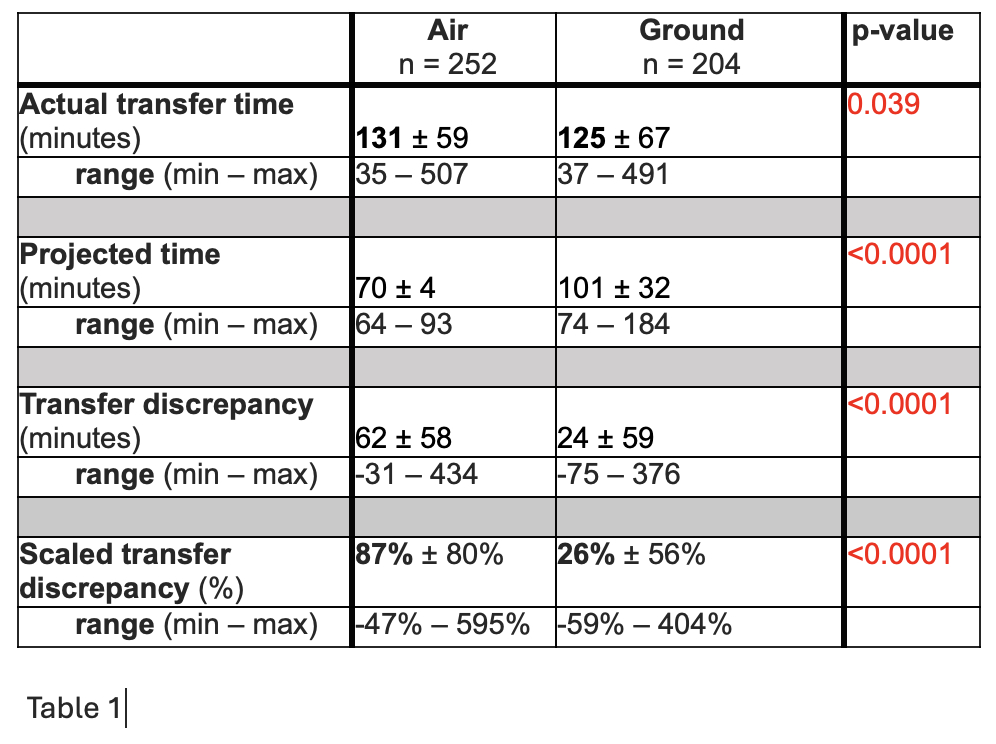Final ID: 148
"Is Air Transport Truly Faster? A Comparative Study of Stroke Transfer Times"
Abstract Body: Introduction:
Efficient transfer of acute ischemic stroke (AIS) patients is critical for optimizing clinical outcomes, as time-sensitive interventions can significantly reduce morbidity and mortality. Stroke transfers are commonly conducted using either ground ambulances or air ambulances (helicopters). While air transport is often perceived as faster, there are concerns that many patients arrive later than expected, impacting treatment outcomes. This study aims to evaluate and compare the performance of ground versus air transfers in terms of actual transfer times and the discrepancies between projected and actual arrival times.
Methods:
This retrospective analysis was conducted at our comprehensive stroke center at the University of Kansas Health System (TUKHS) over a five-year period (2019-2023). Data were sourced from our transfer center registry and the Get With The Guidelines® (GWTG) Stroke registry, focusing on AIS patient transfers from referring hospitals within a 2.5-hour driving radius that had utilized both ground and air methods at least three times over the last 5 years. Data acquisition was approved by the local Institutional Review Board (IRB). Actual transfer times and the discrepancies between projected and actual times were calculated and analyzed.
Results:
456 transfer entries were analyzed, comprising 252 air transfers and 204 ground transfers from 16 hospitals. Ground transfers were found to be faster overall and had a significantly shorter discrepancy between projected and actual arrival times. Specifically, the average actual transfer time for air was 131 ± 59 minutes, compared to 125 ± 67 minutes for ground (p = 0.039). The discrepancy in transfer times was notably higher for air at 62 ± 58 minutes versus 24 ± 59 minutes for ground (p < 0.0001), with a scaled transfer discrepancy of 87% ± 80% for air compared to 26% ± 56% for ground (p < 0.0001).
Conclusion:
While air transport is generally expected to expedite stroke transfers, this retrospective analysis demonstrates that ground transfers are not only faster in actual time but also exhibit a lower discrepancy between projected and actual transfer times. These findings suggest that air transport may not always provide the anticipated time advantage and that ground transfers could be a more reliable option within certain parameters. Further studies are warranted to analyze potential confounding factors for delays, optimize transfer protocols, and improve patient outcomes.
Efficient transfer of acute ischemic stroke (AIS) patients is critical for optimizing clinical outcomes, as time-sensitive interventions can significantly reduce morbidity and mortality. Stroke transfers are commonly conducted using either ground ambulances or air ambulances (helicopters). While air transport is often perceived as faster, there are concerns that many patients arrive later than expected, impacting treatment outcomes. This study aims to evaluate and compare the performance of ground versus air transfers in terms of actual transfer times and the discrepancies between projected and actual arrival times.
Methods:
This retrospective analysis was conducted at our comprehensive stroke center at the University of Kansas Health System (TUKHS) over a five-year period (2019-2023). Data were sourced from our transfer center registry and the Get With The Guidelines® (GWTG) Stroke registry, focusing on AIS patient transfers from referring hospitals within a 2.5-hour driving radius that had utilized both ground and air methods at least three times over the last 5 years. Data acquisition was approved by the local Institutional Review Board (IRB). Actual transfer times and the discrepancies between projected and actual times were calculated and analyzed.
Results:
456 transfer entries were analyzed, comprising 252 air transfers and 204 ground transfers from 16 hospitals. Ground transfers were found to be faster overall and had a significantly shorter discrepancy between projected and actual arrival times. Specifically, the average actual transfer time for air was 131 ± 59 minutes, compared to 125 ± 67 minutes for ground (p = 0.039). The discrepancy in transfer times was notably higher for air at 62 ± 58 minutes versus 24 ± 59 minutes for ground (p < 0.0001), with a scaled transfer discrepancy of 87% ± 80% for air compared to 26% ± 56% for ground (p < 0.0001).
Conclusion:
While air transport is generally expected to expedite stroke transfers, this retrospective analysis demonstrates that ground transfers are not only faster in actual time but also exhibit a lower discrepancy between projected and actual transfer times. These findings suggest that air transport may not always provide the anticipated time advantage and that ground transfers could be a more reliable option within certain parameters. Further studies are warranted to analyze potential confounding factors for delays, optimize transfer protocols, and improve patient outcomes.
More abstracts on this topic:
Attributing Ischemic Heart Disease Patients to Physicians: An Assessment of Claims-based Accountable Care Organization Attribution Methods
Magid David, Luo Qian, Moghtaderi Ali, Klasco Richard, Kini Vinay
Course and Outcomes of Prehospital Advanced Airway Management Efforts in the Pragmatic Airway Resuscitation Trial (PART)Moeller Kim, Powell Jonathan, Gage Christopher, Panchal Ashish, Wang Henry
Readers' Comments
We encourage you to enter the discussion by posting your comments and questions below.
Presenters will be notified of your post so that they can respond as appropriate.
This discussion platform is provided to foster engagement, and simulate conversation and knowledge sharing.
You have to be authorized to post a comment. Please, Login or Signup.
Rate this abstract
(Maximum characters: 500)

